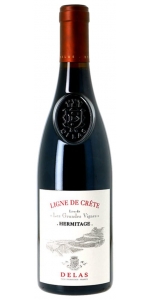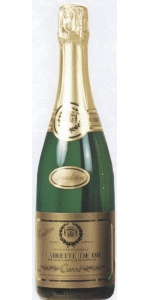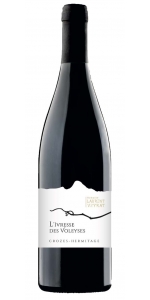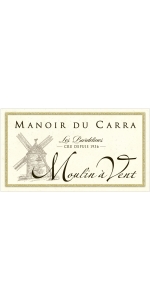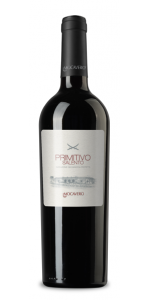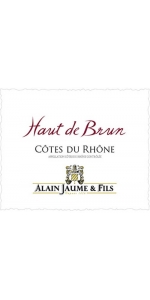Cave de Tain Crozes Hermitage Les Haut du Fief 2009
| Country: | France |
| Regions: | Rhone Crozes Hermitage |
| Winery: | Cave de Tain |
| Grape Type: | Syrah |
| Vintage: | 2009 |
| Bottle Size: | 750 ml |
Delas Hermitage Les Grandes Vignes Ligne de Crete is made from Syrah.
The nose discloses aromas of spice and leather intertwined with deep berry aromas (blackberry, redcurrant) and heady floral notes, liquorice and incense. Its richness, complexity and elegance are by no means a contradiction. The finest granite soils of the Hermitage hillside are to thank for this wine's incredible minerality and finesse. The wine is rich and dense on entry to the palate, where it shows an elegant, broad and flavorsome character. The ripe, smooth and well-integrated tannins contribute to the wine's powerful yet harmonious structure. The palate reveals the same aromas as those found on the nose with nuances of blueberry, raspberry, violet and bitter chocolate. Ligne de Crête is characterized by its exceptional structure, harmony and balance.
This remarkably smooth and elegant wine makes the perfect partner for a pigeon pie, beef tartare ravioli or a roast fillet of deviled duckling with cranberries. It also makes an excellent choice for woodcock, hare "à la Royale" or even a roast rack of lamb in a herb crust.
Review:
Whiffs of espresso, ore and charred meat mingle into thunderous flavors of crème de cassis and roasted plums in this wine. A single-site expression of Les Grandes Vignes from a ripe yet fresh vintage, it's a showstopping Syrah marked with a creamy texture and ripe tannins. Hermitage is not known for youthful pleasures but this rare bottling embraces the hedonism of adolescence along with its potential to gain power and complexity far beyond 2050. Anna Lee C. Iijima
-Wine Enthusiast 97 Points
Inky ruby color. Expansive, smoke- and mineral-accented black and blue fruits, licorice, smoky bacon, mocha, violet and licorice on the highly perfumed nose. Appealingly sweet, mineral-accented cassis, boysenberry, fruitcake, floral pastille and vanilla flavors show superb depth and become spicier with aeration. Shows superb detail and mineral lift on the youthfully tannic, extremely persistent and incisive finish, which features resonating floral and exotic spice notes.
-Vinous 97 Points
Cave Carod Clairette de Die is made from 75% Muscat Petits Grains and 25% Clairette. Clairette de Die is produced with the ancestral dioise method.
The grapes are rapidly pressed after the harvest and then placed in vats at low temperatures (replicating the process used by the Voconces in ancient times who kept the jars in the icy waters of their local rivers). The half-fermented must is bottled and fermentation continues in the bottle, giving a naturally sparkling wine. Disgorging occurs at least six months after bottling, while the wine still contains sugar and has reached an alcohol content of 7 to 9 %.
This is a sparkling wine with very fine bubbles, light in alcohol (8°), and containing residual sugar (incomplete fermentation). Clairette de Die has been known since ancient times (dates back to 77 A.D.). Clairette brings delicacy and lightness to the wine whereas Muscat gives its typical sweet flavor. The wine displays intense aromas, a refreshing balance of fruit and acidity with peach, orange and white flowers flavors.
This is an ideal wine for all desserts and ice creams, and is very interesting with foie gras. It is especially suitable for daytime meetings and cocktail parties. A great breakfast wine!
Wine to be consumed young, to conserve the full fruity and floral flavors. To be stored flat in a cool room away from light.
GOLD MEDAL - Effervescents du Monde 2010
GOLD MEDAL - Concours General Agricole de Paris 2012
SILVER MEDAL - Concours General Agricole de Paris 2011
Laurent Veyrat Crozes Hermitage l'ivresse des Voleyses is made from 100% Syrah.
Review:
"Slightly more expensive, the 2020 Crozes-Hermitage L’Ivresse Des Voleyses is similarly purple-hued and has a great nose of ripe red and blue fruits interwoven with plenty of pepper, flowery incense, and spicy nuances. It’s pure, meduim-bodied, and beautifully balanced, with integrated acidity and outstanding length. It’s very much in the style of this classic, balanced vintage and is going to have over a decade of longevity."
-Jeb Dunnuck (2022), 91-93 points
Manoir du Carra Beaujolais Cru Moulin a Vent Les Burdelines is made from 100 percent Gamay,
Cru Moulin-à-Vent is called the “King of Beaujolais” and is known to age the longest and be the most tannic. Measuring 660 hectares (1,630 acres) in size, there are 280 examples of this AOC on the market.
The wine is produced in the lieu-dit “Les Burdelines”, which belongs to the 18 'climates' registered by the National Institute for Designations of Origin.
Intense color between garnet and deep ruby. Red fruit nose with floral, smoky and forest notes. The mouth is rich and well structured. In a few years the aromas will evolve towards more spice, musk and venison
Mocavero Primitivo del Salento is 100% Primitivo.
Deep red color with hints of violet, sweet spicy and ripe fruity notes, soft, persistent taste with skilful balanced tannins.
This ancient vine variety requires special attention during vinification to ensure that it expresses all the varietal characteristics, it needs periodic aeration and a particular temperature control. Once maceration is complete, the must is separated from the marc and fermentation ends in stainless steel tanks.Once it has been fermented the wine is refined in american Oak barrels for 3-4 months. When the refining process is complete, the wine is filtered and bottled.
Pairs best with roast meat, wild fowl, cold-cuts and mature cheese.
Alain Jaume Cotes Du Rhone Rouge Haut de Brun is made from 60% Grenache, 30% Syrah, 10% Cinsault
The colour is purple-tinged garnet.The aromatic range of the nose goes from fresh berries (wild raspberry, blackcurrant, blackberry) to spices.The palate is big and full-flavoured, with silky-smooth tannins and aromas of the fruit already mentioned. The finish introduces touches of liquorice and pepper. A Côtes du Rhône with great complexity for an every day drinking.
A classic Rhône to drink between 1 and 4 years. Best poured at 17°C.
Traditional wine making and ageing is performed in vats only. Bottling after 10-12 months.
Ideal throughout the meal, but particularly with poultry and other white meats, as well as mild cheeses.
Cave de Tain Crozes Hermitage Les Haut du Fief is made with 100% Syrah.
Type of Soil: The soil is stony, warm and filtering. It is made up of fluvioglacial alluvium. Extremely dry in summer, it favours healthy and early maturing of grapes.
Yield: 35 hl / ha.
Production: 30,000 bottles
Vinification: This cuvee is a blend from the best terroirs of the AOC Crozes-Hermitage. The vines are at least 20 years old. Long maceration, 80% of the warm wine is run-off into French oak for 12 months.
Characteristics: Deep dense garnet color with purple tints. Harmonious and intense nose of candied fruits and toasty overtones, cocoa beans, liquorice and spicy aromas. The palate is powerful, smooth and elegant. Full-bodied wine with silky tannins and ripe fruit. Well-balanced and exceptional concentration due to good climatic conditions. The peppery finish is long and persistent. A racy wine with over 8 years ageing capacity.
"A ripe red, with dark, alluring roasted fig, espresso and mulled blackberry fruit that manages to stay fresh and racy through the finish, where licorice snap and roasted apple wood notes add length and definition. Drink now through 2014. 6,000 cases made. –JM"
- Wine Spectator (October 15th 2011), 91 pts
The Cave de Tain Estate
Cave de Tain was founded in 1933 by 100 winegrowers from the district of Tain l'Hermitage. Its first president Louis Gambert de Loche was a land owner and a great humanist, from whom the Cave de Tain purchased the Hermitage vineyards.
Today the Cave de Tain has 370 grower-members and a total vineyard area of 1,140 hectares, of which 1,000 hectares are A.O.C. wines. At the foot of the famous Hermitage hillside, the Cave de Tain produces and sells five appellation controlee wines:
- Hermitage
- Crozes-Hermitage
- St-Joseph
- Cornas
- St-Peray
The volume of these five wines vinified by the Cave de Tain represents almost half of the total volume of all northern Rhone AOC wines produced. The Cave also produces single varietal vins de pays wines from Syrah and Marsanne grapes grown on the outskirts of the appellation areas in the northern Rhone hills.
The Cave de Tain Vineyard
The wines of the Cave de Tain are recognized for their quality. The objective of the Cave is to provide wine lovers around the world with authentic wines which bear the full character of their individual " terroir ", bringing out the best through careful and non-intrusive vinification methods.
The winemakers supervise each stage of vinification, from grape reception, classified according to quality, right up to bottling. The cellar team makes every effort to respect the inherent characteristics of each vintage, to ensure a harmonious and natural finished product after vinification. In this highly traditional vineyard, successive generations have contributed to the growth and development of the winery by producing grapes of a quality they strive to constantly improve.
- back
Raats MR Mvemve Raats de Compostella is made from 63% Cabernet Sauvignon, 17% Cabernet Franc, 12% Malbec, 6% Petit Verdot, 2% Merlot
The name de Compostella (meaning “field of stars” or “compilation of stars”) was chosen to reflect the fact that each component is crafted to stand alone as a world class varietal wine. The wine exhibits a deep, dark ruby color. Blackcurrant and black cherry fruit with hints of violets, cedar and cinnamon are revealed on the nose. The palate is rich and complex with mineral, blackberry fruit and dark chocolate on the finish. The five Bordeaux varietals harmoniously convene in this consistent, linear flavor profile that is polished with a well-defined finish.
Review:
he 2020 De Compostella is composed of 30% Cabernet Franc, 28% Cabernet Sauvignon, 21% Malbec, 16% Merlot and 5% Petit Verdot. Beginning with a focused, juicy and complex nose of dark red fruits, the wine has impeccable balance between oak, fruit and earthy floral tones. Full-bodied and with succulent acidity, the palette offers a firm frame of fine-grained tannins, while the fruit profile makes way for elegant earth and notes of crème de cassis sway with subtle flavors of sage and spiced plum. The red blend continues to somersault and reveal its complexities over the long-lingering and ever-evolving finish. Be patient with this exceptional wine
-Wine Advocate 95 Points
Oumsiyat Chardonnay is made from 100 percent Chardonnay.
Intense aromas of luscious tropical fruit notes of ripe peach and pineapple are refreshingly balanced on the palate through to a clean and zesty finish.
RS: 2 g/L
The Chardonnay grapes were sorted prior to vinification to ensure the fruit was healthy and ripe. The grapes were then pressed, and the must was racked to stainless steel fermentation tanks, where the must was fermented at 14 to 16°C with selected yeasts. The wine did not undergo malolactic fermentation to maintain the crisp, fresh style. The wine rested on its fine lees for three months adding texture and subtle complexity before being gently filtered and bottled.


